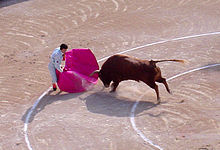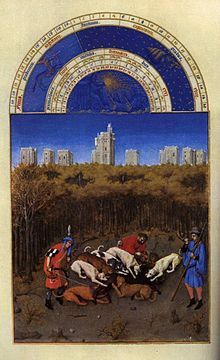Blood sport: Difference between revisions
Cometstyles (talk | contribs) |
|||
| Line 30: | Line 30: | ||
| format = |
| format = |
||
| doi = |
| doi = |
||
| accessdate = 2006-12-17 }}</ref>. Its usage to describe modern [[hunting]] is a matter of dispute. Modern hunters claim to be guided by the ethics of [http://www.boone-crockett.org/huntingEthics/ethics_fairchase.asp?area=huntingEthics fair chase] and claim not to impose needless animal suffering. Those who oppose hunting claim, however, that humans do not need to hunt in order to survive and that hunting, perforce, |
| accessdate = 2006-12-17 }}</ref>. Its usage to describe modern [[hunting]] is a matter of dispute. Modern hunters claim to be guided by the ethics of [http://www.boone-crockett.org/huntingEthics/ethics_fairchase.asp?area=huntingEthics fair chase] and claim not to impose needless animal suffering. Those who oppose hunting claim, however, that humans do not need to hunt in order to survive and that hunting, perforce, Does not inflict needless suffering. |
||
Fuck all you who think hunting is bad ^^ |
|||
===Bull fighting and cock fighting=== |
===Bull fighting and cock fighting=== |
||
Revision as of 20:11, 27 February 2008

Bloodsport or blood sport is a term used to describe sport or entertainment that involves animal suffering.[1]
The term can refer to chase sports such as coursing or beagling, combat sports such as cockfighting, or other activities. These usually involve blood being drawn, and sometimes result in the death of one or more animals.
Use of the term "blood sport"

According to the Oxford English Dictionary, the earliest use of the term is in reference to mounted hunting, where the quarry would be actively chased, as in fox hunting or hare coursing. Before firearms a hunter using arrows or a spear might also wound an animal, which would then be chased and perhaps killed at close range, as in medieval boar hunting. The term was popularised by author Henry S. Salt (1851–1939).
Later, the term seems to have been applied to various kinds of baiting and forced combat: bull-baiting, bear-baiting, cockfighting and later developments such as dog fighting and rat-baiting. The animals were specially bred, confined and forced to fight. In the Victorian era, social reformers began a vocal opposition to such activities, claiming grounds of ethics, morality and animal welfare.
By extension, efforts have been made to apply the term to other activities. Sometimes this is clearly figurative, as when politics is likened to a blood sport. Sometimes this is anachronistic, as when the term is applied retroactively to Roman gladiators. Sometimes it is rhetorical, as when professional boxing is compared to the fatal combats of Ancient Rome.
Current issues
Changes in usage of the term blood sport illustrate the depth of the linguistic and social complexities of social evolution.
Hunting
Animal rights and some animal welfare activists have sought to extend the term blood sport, especially as a pejorative, to a variety of activities not covered by the original use of the term[2]. Its usage to describe modern hunting is a matter of dispute. Modern hunters claim to be guided by the ethics of fair chase and claim not to impose needless animal suffering. Those who oppose hunting claim, however, that humans do not need to hunt in order to survive and that hunting, perforce, Does not inflict needless suffering.
Fuck all you who think hunting is bad ^^
Bull fighting and cock fighting
Today, under lobbying pressure, limitations on blood sports have been enacted in much of the world. Certain blood sports remain legal under varying degrees of control in certain locations (e.g., bull fighting and cockfighting) but have declined in popularity almost everywhere else.[3][4] Proponents of blood sports are widely cited to believe that they are traditional within the culture.[5] Bullfighting aficionados, for example, do not regard bullfighting as a sport but as a cultural activity. It is sometimes called a tragic spectacle, because the bull is invariably killed and the bullfighter is always at risk of death. Both Barnaby Conrad's La Fiesta Brava and Hemingway's Death in the Afternoon offer opinion on this matter.
YouTube Blood sport
The video sharing site YouTube has been criticized by the RSPCA, among others, for hosting videos of animal conflict staged specifically to be shown on YouTube, especially the feeding of one animal to another for the purposes of entertainment. [6] [7]
List of blood sports
- Badger-baiting
- Bear-baiting
- Betta-fighting
- Bull-baiting
- Bullfighting
- Cockfighting
- Cock throwing
- Cricket fighting
- Dog fighting
- Fox hunting
- Fox tossing
- Gladiatoral spectacles
- Hare coursing
- Hog dogging
- Human-baiting
- Insect fighting
- Rat baiting
- Spider fighting
- Wolf hunting
Campaigning organizations
See also
External links
- Irish Council Against Blood Sports
- YouTube footage of a captive deer being pursued by hounds and horsemen
References
- ^ Hunting Social Analysis, American Sports Data.
- ^ Greenwood, George (1914). "Bloodsports". Stag Hunting pp. 1–33, in Killing for Sport: Essays by Various Writers, edited by Henry S. Salt. George Bell and Sons, Ltd, London. Retrieved 2006-12-17.
{{cite web}}: Cite has empty unknown parameter:|coauthors=(help) - ^ Lewine, Edward (July 2005). Death and the Sun: A Matador's Season in the Heart of Spain. Houghton Mifflin Company. ISBN: 061826325X.
{{cite book}}: Cite has empty unknown parameter:|coauthors=(help) - ^ Mitchell, Timothy (July 1991). Blood Sport: a social history of Spanish bullfighting. University of Pennsylvania Press. p. 244. ISBN-10: 0812231295.
{{cite book}}: Cite has empty unknown parameter:|coauthors=(help); Text "ISBN-13: 978-0812231298" ignored (help) - ^ Cockfighting, Puerto Rico Herald, 2005.
- ^ Times online, [1] August 19, 2007, retrieved August 25, 2007.
- ^ Practical Fishkeeping, [2] May 17, 2007, retrieved August 25, 2007.
